The Spatial Distribution and Transition of Meteorological and Ecological Droughts in the Shendong Mining Area
Abstract
1. Introduction
2. Materials and Methods
2.1. Study Area
2.2. Data Sources
2.2.1. Gross Primary Production (GPP) Data
2.2.2. Climate Data
2.2.3. Land Use/Land Cover Data
2.3. Methodology
2.3.1. Ecological Drought Identification Method
2.3.2. Meteorological Drought Identification Method
2.3.3. Estimation of Drought Event Characteristics
2.3.4. Event Transition Identification Method
3. Results
3.1. Spatial Distribution of Meteorological Drought Characteristics in the Shendong Mining Area
3.2. Spatial Distribution of Ecological Drought Characteristics in the Shendong Mining Area
3.3. Analysis of Drought Characteristics of Stable Land Uses in the Shendong Mining Area
3.3.1. Stable Region Meteorological Drought Characteristics
3.3.2. Stable Region Ecological Drought Characteristics
3.4. Analysis of Regional Drought Characteristics of Converted Land Uses in the Shendong Mining Area
3.4.1. Change Region Meteorological Drought Characteristics
3.4.2. Change Region Ecological Drought Characteristics
3.5. Transition Frequency and Correlation Between Meteorological Drought and Ecological Drought
4. Discussion
4.1. Spatial Distribution Analysis of Drought Characteristics
4.2. Analysis of Drought Characteristics of Different Land Use Types
4.3. Transition from Meteorological Drought to Ecological Drought
5. Conclusions
6. Deficiencies and Prospects
6.1. Deficiencies
6.2. Prospects
Author Contributions
Funding
Data Availability Statement
Acknowledgments
Conflicts of Interest
References
- Zhao, S.T.; Zhou, R.; Yuan, S.B.; Li, E.H. Protection and Restoration of Shallow Lake Wetland Plants in the Middle and Lower Reaches of the Yangtze River. People’s Yangtze River 2025, 56, 1–19. [Google Scholar]
- Tran, T.-N.-D.; Lakshmi, V. Enhancing human resilience against climate change: Assessment of hydroclimatic extremes and sea level rise impacts on the Eastern Shore of Virginia, United States. Sci. Total Environ. 2024, 947, 174289, ISSN 0048-9697. [Google Scholar] [CrossRef]
- Tran, T.-N.-D.; Tapas, M.R.; Do, S.K.; Etheridge, R.; Lakshmi, V. Investigating the impacts of climate change on hydroclimatic extremes in the Tar-Pamlico River basin, North Carolina. J. Environ. Manag. 2024, 363, 121375, ISSN 0301-4797. [Google Scholar] [CrossRef]
- Wang, Y.L.; Wang, R.; Shan, F.J.; Zhang, Y.X.; Zhao, Y.; Sun, Y. Drought Characteristics Analysis of Corn in Liaoning Province Based on SPEI Index. J. Liaoning Univ. Technol. (Nat. Sci. Ed.) 2024, 44, 273–280. [Google Scholar]
- He, L.J.; Long, H.; Li, L.J.; Zhao, Z.Y. Collaborative Visual Analysis of Spatiotemporal Evolution of Agricultural Drought Index in Guizhou. J. Agric. Big Data 2024, 6, 532–545. [Google Scholar]
- Gao, J.; Jing, L.H.; Li, H.Y.; Miao, Y.L.; Jing, L.J. Precipitation and Meteorological Drought Change Characteristics in the Tacheng Area of Xinjiang Over the Past 60 Years. Plateau Mt. Meteorol. Res. 2024, 44, 134–142. [Google Scholar]
- Xue, L.; Yuan, S.J.; Wang, J.S. Research Progress and Prospects on the Causes of Meteorological Drought in Different Regions of China. Arid. Meteorol. 2023, 41, 1–13. [Google Scholar]
- Fan, H.; Dang, X.H.; Zhao, J.Y.; Wang, X.X.; Cheng, X.Q.; Lin, Q.R. Spatiotemporal Changes of Drought in the Arid Northwest Region Based on the Temperature Vegetation Drought Index. Sci. Technol. Eng. 2024, 24, 11537–11546. [Google Scholar]
- Song, Y.L. Research Progress on Global Drought Indices. J. Appl. Meteorol. Sci. 2022, 33, 513–526. [Google Scholar]
- Li, B.; Xie, J.C.; Hu, Y.H.; Jiang, R.G. Analysis of Spatiotemporal Changes of Drought in Shaanxi Province Based on the Standardized Precipitation Index. Trans. Chin. Soc. Agric. Eng. 2017, 33, 113–119. [Google Scholar]
- Li, Y.; Jiang, W.; Chen, X.J.; Wu, Y.J.; Wang, S. Trend of Meteorological Drought from 1961 to 2020 in Ordos Based on the Percentage Deviation of Precipitation. Res. Arid. Zones 2024, 41, 1099–1111. [Google Scholar]
- Han, H.T.; Hu, W.C.; Chen, X.J.; Wang, N.A.; Li, G. Comparative Study on Three Meteorological Drought Indices. Res. Arid. Zones 2009, 27, 237–241. [Google Scholar]
- Tao, R.; Zhang, K. Analysis of Meteorological Drought Characteristics and Spatiotemporal Changes in China from 1982 to 2015 Based on PDSI. Water Resour. Prot. 2020, 36, 50–56. [Google Scholar]
- Wang, C.X.; Zhang, S.Q.; Chen, W.X.; Sun, R. Applicability Analysis and Revision of the Meteorological Drought Composite Index (MCI) in Sichuan Province. Chin. Agric. Sci. Bull. 2019, 35, 115–121. [Google Scholar]
- Vicente-Serrano, S.-M.; Begueria, S.; Lopez-Moreno, J.-I. A Multiscalar Drought Index Sensitive to Global Warming: The Standardized Precipitation Evapotranspiration Index. J. Clim. 2010, 23, 1696–1718. [Google Scholar] [CrossRef]
- Gao, Y.; Feng, J.; Zhang, C.; Weng, B.; Qin, T. Research Progress on Drought Assessment Indicator System. J. Anhui Agric. Sci. 2012, 40, 11659–11663. [Google Scholar]
- Wang, F.; Wang, Z.M.; Yang, H.B.; Zhao, Y. Spatiotemporal Pattern of Drought in the Yellow River Basin Based on SPEI. Sci. China Earth Sci. 2018, 48, 1169–1183. [Google Scholar]
- Shi, X.; Chen, F.; Ding, H.; Shi, M.; Li, Y. Assessing Vegetation Ecosystem Resistance to Drought in the Middle Reaches of the Yellow River Basin, China. Int. J. Environ. Res. Public Health 2022, 19, 4180. [Google Scholar] [CrossRef]
- Liang, S.Z.; Sui, X.Y.; Wang, M.; Li, X.H.; Dong, H.Y.; Yao, H.M.; Ma, W.D. Multi-timescale Dry-Wet Changes in the Yellow River Basin Based on SPEI. Res. Soil Water Conserv. 2022, 29, 231–241. [Google Scholar]
- Liu, D.; Esquivel-Muelbert, A.; Acil, N.; Astigarraga, J.; Cienciala, E.; Fridman, J.; Kunstler, G.; Matthews, T.J.; Ruiz-Benito, P.; Sadler, J.P.; et al. Mapping multi-dimensional variability in water stress strategies across temperate forests. Nat. Commun. 2024, 15, 8909. [Google Scholar] [CrossRef]
- Sadiqi, S.-S.-J.; Hong, E.-M.; Nam, W.-H.; Kim, T. Review: An integrated framework for understanding ecologicaldrought and drought resistance. Sci. Total Environ. 2022, 846, 157477. [Google Scholar] [CrossRef]
- Karmaoui, A.; El Jaafari, S.; Chaachouay, H.; Hajji, L. The socioecological system of the pre-Sahara zone of Morocco: A con-ceptual framework to analyse the impact of drought and desertification. GeoJournal 2022, 87, 4961–4974. [Google Scholar] [CrossRef]
- Paz, H.; Pineda-García, F.; Pinzón-Pérez, L.F. Root depth and morphology in response to soil drought: Comparing ecological groups along the secondary succession in a tropical dry forest. Oecologia 2015, 179, 551–561. [Google Scholar] [CrossRef]
- Su, X.; Jiang, T.; Niu, J. Concept and research progress of ecological drought. Water Res. Prot. 2021, 37, 15–21. [Google Scholar]
- Lan, M.Y.; Zhou, D.Z.; Guan, Y.H. Spatiotemporal Changes of Normalized Vegetation Index and Its Driving Factors in Yan’an City. J. Zhejiang AF Univ. 2024, 41, 1293–1302. [Google Scholar]
- Wen, X.D.; Luo, Z.H.; Fu, L.G. Impact of Climate and Land Use Changes on the Spatiotemporal Variation of Enhanced Vege-tation Index in the Guangdong-Hong Kong-Macao Greater Bay Area. Ecol. Sci. 2023, 42, 222–232. [Google Scholar]
- Yin, B.S.; Li, Z.F.; Yue, R.; Lv, S.H.; Li, F.L. Monitoring of Drought Conditions in the Guanzhong Area Based on the Temperature Vegetation Drought Index. Trans. Chin. Soc. Agric. Eng. 2024, 40, 111–119. [Google Scholar]
- Eltahir, E.A.B.; Yeh, P.J.F. On the asymmetric response of aquifer water level to floods and droughts in Illinois. Water Resour. Res. 1999, 35, 1199–1217. [Google Scholar] [CrossRef]
- Peters, E. Propagation of Drought Through Groundwater Systems: Illustrated in the Pang (UK) and Upper-Guadiana(ES) Catch-ments. Ph.D. Thesis, Wageningen University, Wageningen, The Netherlands, 2003. [Google Scholar]
- Konapala, G.; Mishra, A. Review of complex networks application in hydroclimatic extremes with an implementation to char-acterize spatio-temporal drought propagation in continental USA. J. Hydrol. 2017, 555, 600–620. [Google Scholar] [CrossRef]
- Mishra, A.-K.; Ines, A.-V.-M.; Das, N.-N.; Khedun, C.P.; Singh, V.P.; Sivakumar, B.; Hansen, J.W. Anatomy of a local-scale drought: Application of assimilated remote sensing products, crop model, and statistical methods to an agricultural drought study. J. Hydrol. 2015, 52, 615–629. [Google Scholar] [CrossRef]
- Han, Z.; Huang, S.; Huang, Q.; Leng, G.; Wang, H.; Bai, Q.; Zhao, J.; Ma, L.; Wang, L.; Du, M. Propagation dynamics from meteorological to groundwater drought and their possible influence factors. J. Hydrol. 2019, 57812. [Google Scholar] [CrossRef]
- Guo, Y.; Huang, S.; Huang, Q.; Leng, G.; Fang, W.; Wang, L.; Wang, H. Propagation thresholds of meteorological drought for triggering hydrological drought at various levels. Sci. Total Environ. 2020, 712, 136502. [Google Scholar] [CrossRef]
- Han, Z.; Huang, S.; Huang, Q.; Bai, Q.; Leng, G.; Wang, H.; Zhao, J.; Wei, X.; Zheng, X. Effects of vegetation restoration on groundwater drought in the Loess Plateau, China. J. Hydrol. 2020, 591, 125566. [Google Scholar] [CrossRef]
- Su, X.L.; Chu, J.D.; Zhang, T.; Jiang, T.L.; Wang, G.Z. Spatiotemporal Evolution Trend of Groundwater Drought and Its Dynamic Response to Meteorological Drought in Northwest China. Water Resour. Prot. 2022, 38, 34–42. [Google Scholar]
- Wang, Y.; Zhang, Y.; Cheng, Y.; Xu, L.; Guo, J.; Wang, H.; Li, J.; Du, S.H. Remote Sensing Monitoring and Spatiotemporal Change Analysis of Vegetation Cover under Coal Mining Activities in the Shendong Mining Area from 1986 to 2023. Remote Sens. Nat. Resour. 2024, 1–11. [Google Scholar]
- Chen, Z.; Zhu, Z.; Zhang, X.; Jiao, Y.; Cheng, Y.; Wang, S.; Zhang, H. Study on spatiotemporal evolution of ecosystem services, spatio-temporal pattern of tradeoff/synergy relationship and its driving factors in Shendong mining area. Front. Environ. Sci. 2024, 12, 1445833, ISSN 2296-665X. [Google Scholar]
- Jia, Y.; Chen, S.; Deng, Q. Impact of Surface Fractures Induced by Multiple Coal Seam Mining on Soil Physicochemical Properties. Res. Soil Water Conserv. 2025, 32, 98–107. [Google Scholar]
- Zhang, Y.; He, S. PML-V2(China): Evapotranspiration and Gross Primary Production Dataset (2000.02.26–2020.12.31); National Tibetan Plateau/Third Pole Environment Data Center: Beijing, China, 2022. [Google Scholar] [CrossRef]
- He, S.; Zhang, Y.; Ma, N.; Tian, J.; Kong, D.; Liu, C. A daily and 500 m coupled evapotranspiration and gross primary production product across China during 2000–2020. Earth Syst. Sci. Data 2022, 14, 5463–5488. [Google Scholar] [CrossRef]
- Zhang, Y.; Kong, D.; Gan, R.; Chiew, F.H.S.; McVicar, T.R.; Zhang, Q.; Yang, Y. Coupled estimation of 500m and 8-day resolution global evapotranspiration and gross primary production in 2002–2017. Remote Sens. Environ. 2019, 222, 165–182. [Google Scholar] [CrossRef]
- Zhang, Y.; Peña-Arancibia, J.L.; McVicar, T.R.; Chiew, F.H.S.; Vaze, J.; Liu, C.; Lu, X.; Zheng, H.; Wang, Y.; Liu, Y.Y.; et al. Multi-decadal trends in global terrestrial evapotranspiration and its components. Sci. Rep. 2016, 6, 19124. [Google Scholar] [CrossRef]
- Peng, S. 1-km monthly precipitation dataset for China (1901–2023); National Tibetan Plateau/Third Pole Environment Data Center: Beijing, China, 2020. [Google Scholar]
- Peng, S.Z.; Ding, Y.X.; Wen, Z.M.; Chen, Y.M.; Cao, Y.; Ren, J.Y. Spatiotemporal change and trend analysis of potential evapotranspiration over the Loess Plateau of China during 2011–2100. Agric. For. Meteorol. 2017, 233, 183–194. [Google Scholar] [CrossRef]
- Ding, Y.X.; Peng, S.Z. Spatiotemporal trends and attribution of drought across China from 1901–2100. Sustainability 2020, 12, 477. [Google Scholar] [CrossRef]
- Peng, S.Z.; Ding, Y.X.; Liu, W.Z.; Li, Z. 1 km monthly temperature and precipitation dataset for China from 1901 to 2017. Earth Syst. Sci. Data 2019, 11, 1931–1946. [Google Scholar] [CrossRef]
- Peng, S.; Gang, C.; Cao, Y.; Chen, Y. Assessment of climate change trends over the loess plateau in China from 1901 to 2100. Int. J. Climatol. 2017, 38, 2250–2264. [Google Scholar] [CrossRef]
- Yang, J.; Huang, X. The 30 m annual land cover datasets and its dynamics in China from 1985 to 2022 [Data set]. In Earth System Science Data; Zenodo: Genève, Switzerland, 2023; Volume 13, pp. 3907–3925. [Google Scholar]
- Tian, X.; Shao, X.; Zhang, Y.; Feng, R.; Wu, T.; Chen, B.; Bian, N. Spatial distribution and transmission relationship of meteorological drought and ecological drought in Ordos in recent 20 years. Geogr. Res. 2019, 43, 1878–1890. [Google Scholar]
- Yu, Z.; Wang, J.; Liu, S.; Rentch, J.S.; Sun, P.; Lu, C. Global gross primary productivity and water use efficiency changes under drought stress. Environ. Res. Lett. 2017, 12, 014016. [Google Scholar] [CrossRef]
- Wei, X.; He, W.; Zhou, Y.; Ju, W.; Xiao, J.; Li, X.; Liu, Y.; Xu, S.; Bi, W.; Zhang, X.; et al. Global assessment of lagged and cumulative effects of drought on grassland gross primary production. Ecol. Indic. 2022, 136, 108646. [Google Scholar] [CrossRef]
- Zhang, X.; Wang, R.; Shan, F.; Zhang, T.; Wang, Y. Spatiotemporal distribution characteristics of drought in the three northeastern provinces of China from 1961 to 2020. J. Irrig. Drain. 2024, 43, 78–88. [Google Scholar]
- Xiao, P.; Ma, Z.Z.; Zhang, X.H.; Xiao, X.; Gou, Q.S.; Guo, M.Y.; Lin, P.F. Groundwater drought characteristics and dynamic response to meteorological drought in the plain area of Qingdao. Water Resour. Hydropower Technol. (Chin. Engl.) 2025, 1–21. [Google Scholar]
- Li, J.Z.; Wang, Y.X.; Li, S.F.; Hu, R. A Nonstationary Standardized Precipitation Index incorporating climate indices as covariates. J. Geophys. Res. Atmos. 2015, 120, 12082–12095. [Google Scholar] [CrossRef]
- Khoshnazar, A.; Corzo Perez, G.A. Wet-environment Evapotranspiration and Precipitation Standardized Index (WEPSI) for drought assessment and monitoring. Earth Syst. Sci. Data 2021, 13, 1393–1411. [Google Scholar] [CrossRef]
- Wen, G.T.; Bai, J.J.; Sun, S.S. Analysis of drought variation characteristics in Shaanxi Province from 2004 to 2014 based on time series remote sensing data. Arid. Zone Res. 2018, 36, 221–229. [Google Scholar]
- Li, Y.; Huang, Y.; Li, Y.; Zhang, H.; Fan, J.; Deng, Q.; Wang, X. Spatiotemporal heterogeneity in meteorological and hydrological drought patterns and propa-gations influenced by climatic variability, LULC change, and human regulations. Sci. Rep. 2024, 14, 5965. [Google Scholar]
- Yin, Y.; Ma, D.; Wu, S. Enlargement of the semi-arid region in China from 1961 to 2010. Clim. Dyn. 2019, 52, 509–521. [Google Scholar] [CrossRef]
- Xu, Q. Ecological Restoration Technology Evaluation in the Shendong Mining Area. Master’s Thesis, China University of Mining and Technology, Xuzhou, China, 2022. [Google Scholar]
- Shao, T.Y. Study on the Dynamic Changes of Soil Surface Moisture Content in Shendong Mining Area Based on TVDI. Master’s Thesis, Inner Mongolia Agricultural University, Hohhot City, China, 2023. [Google Scholar]
- Li, Y.; Zhang, Q.; Zhang, A.; Chen, Y.; Yang, M. Characteristics and influencing factors of boundary layer change in arid and semi-arid region. Plateau Meteorol. 2016, 35, 385–396. [Google Scholar]
- Liu, Y.; Lei, S.; Chen, X.; Chen, M.; Yang, Y.M.; Li, X.H.; Zhang, X.Y.; Long, L.; Bian, Z. Analysis of temporal changes and driving factors of vegetation coverage in Shendong Mining area and its guided restoration strategy. J. China Coal Soc. 2021, 46, 3319–3331. [Google Scholar]
- Zhou, G.Y.; Zhou, L.Y.; Shao, J.J.; Zhou, X.H. Effects of extreme drought on terrestrial ecosystems: Review and prospects. Chin. J. Plant Ecol. 2020, 44, 515–525. [Google Scholar] [CrossRef]
- Jiang, R.; Liang, J.; Zhao, Y.; Wang, H.; Xie, J.; Lu, X.; Li, F. Assessment of vegetation growth and drought conditions using satellite-based vegetation health indices in Jing-Jin-Ji region of China. Sci. Rep. 2021, 11, 13775. [Google Scholar] [CrossRef]
- Su, J.; Fan, L.; Yuan, Z.; Wang, Z.; Wang, Z. Quantifying the drought sensitivity of grassland under different climate zones in Northwest China. Sci. Total Environ. 2024, 910, 168688. [Google Scholar] [CrossRef]
- Zhang, Y.-W.; Wang, K.-B.; Wang, J.; Liu, C.; Shangguan, Z.-P. Changes in soil water holding capacity and water availability following vegetation restoration on the Chinese Loess Plateau. Sci. Rep. 2021, 11, 9692. [Google Scholar] [CrossRef]
- Gao, S.; Wang, F.; Men, R.; Yan, S.; Wang, Z.; Lai, H.; Li, Y.; Guo, W. The Propagation Characteristics of Meteorological Drought to Vegetation Drought Based on Three-Dimensional Clustering Algorithm in China. Agronomy 2024, 14, 2067. [Google Scholar] [CrossRef]
- Zhang, L.; Chang, J.X.; Guo, A.; Zhou, K.; Yang, G.; Zou, D. Ecological drought evolution characteristics under different climatic regions in the Yangtze River basin. J. Hydrol. 2023, 629, 130573. [Google Scholar] [CrossRef]
- Zhao, A.Z.; Liu, X.F.; Zhu, X.F.; Pan, Y.Z.; Chen, S.C. Spatiotemporal changes of vegetation cover in the Loess Plateau from 2000 to 2014 and their attribution. Chin. Environ. Sci. 2016, 36, 1568–1578. [Google Scholar]
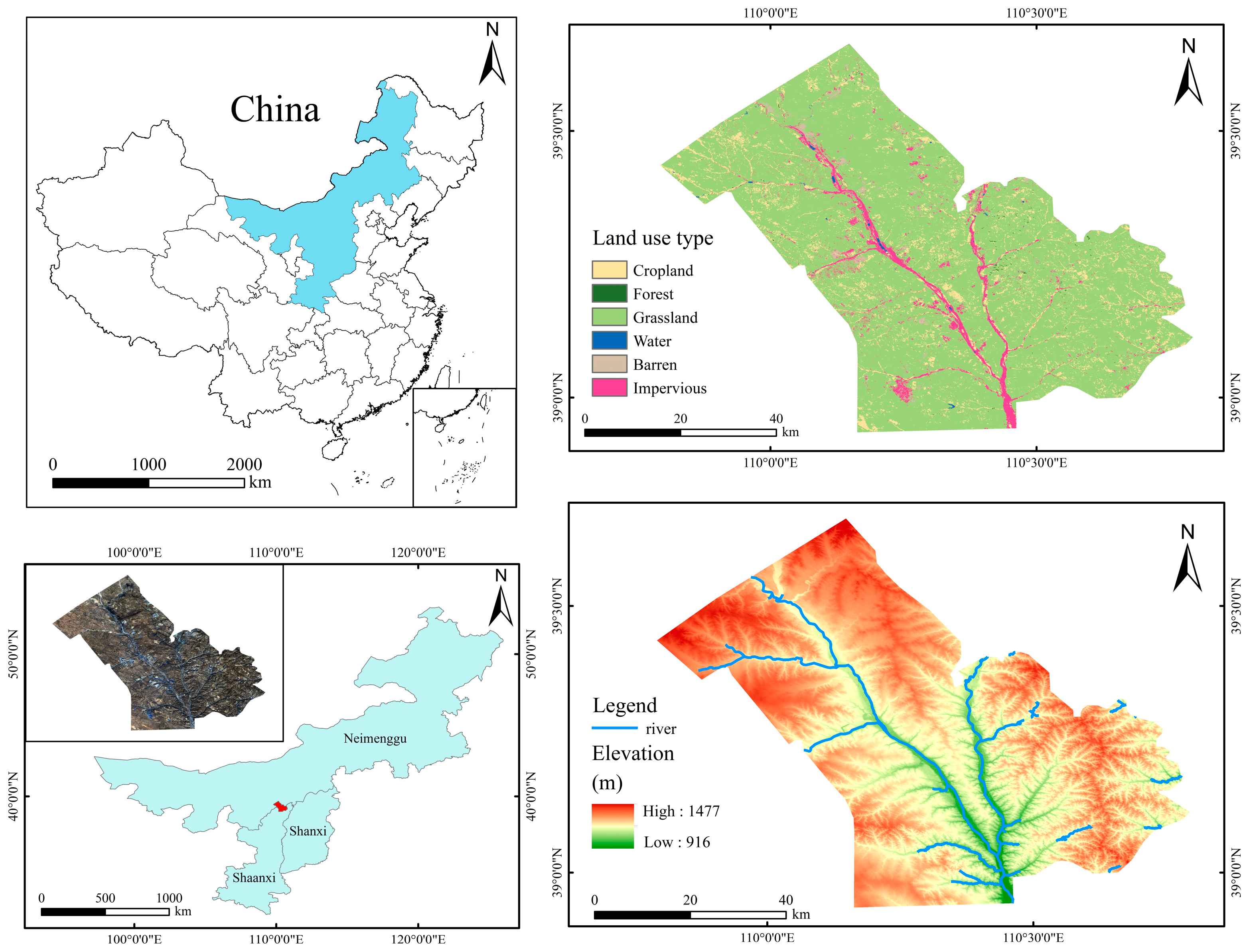
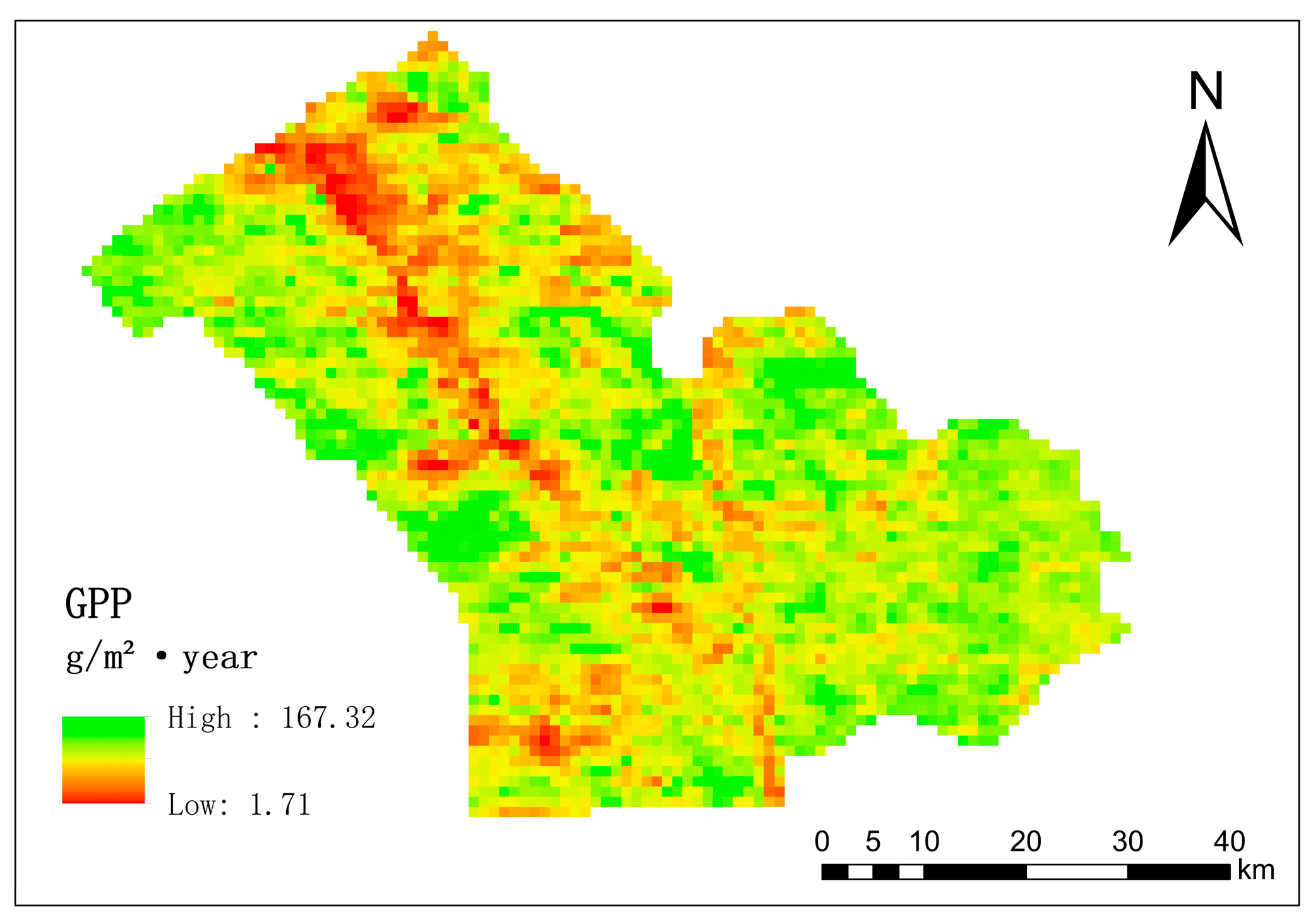
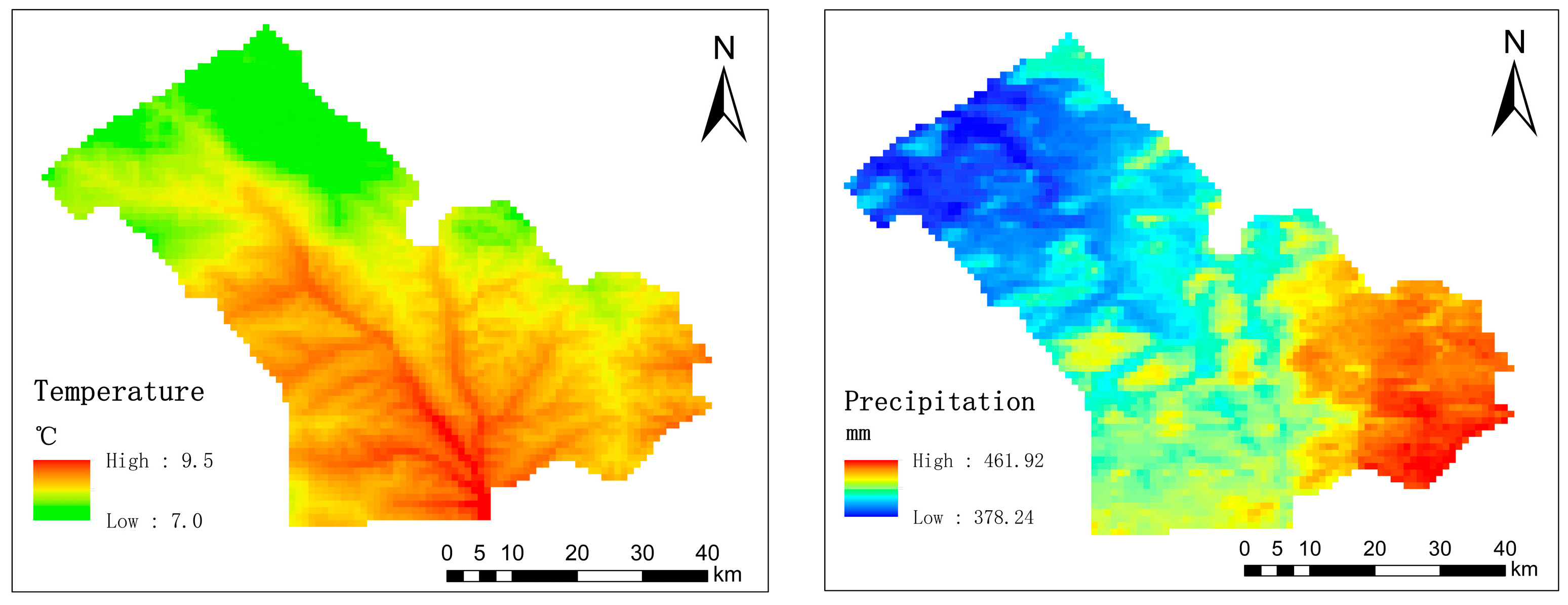




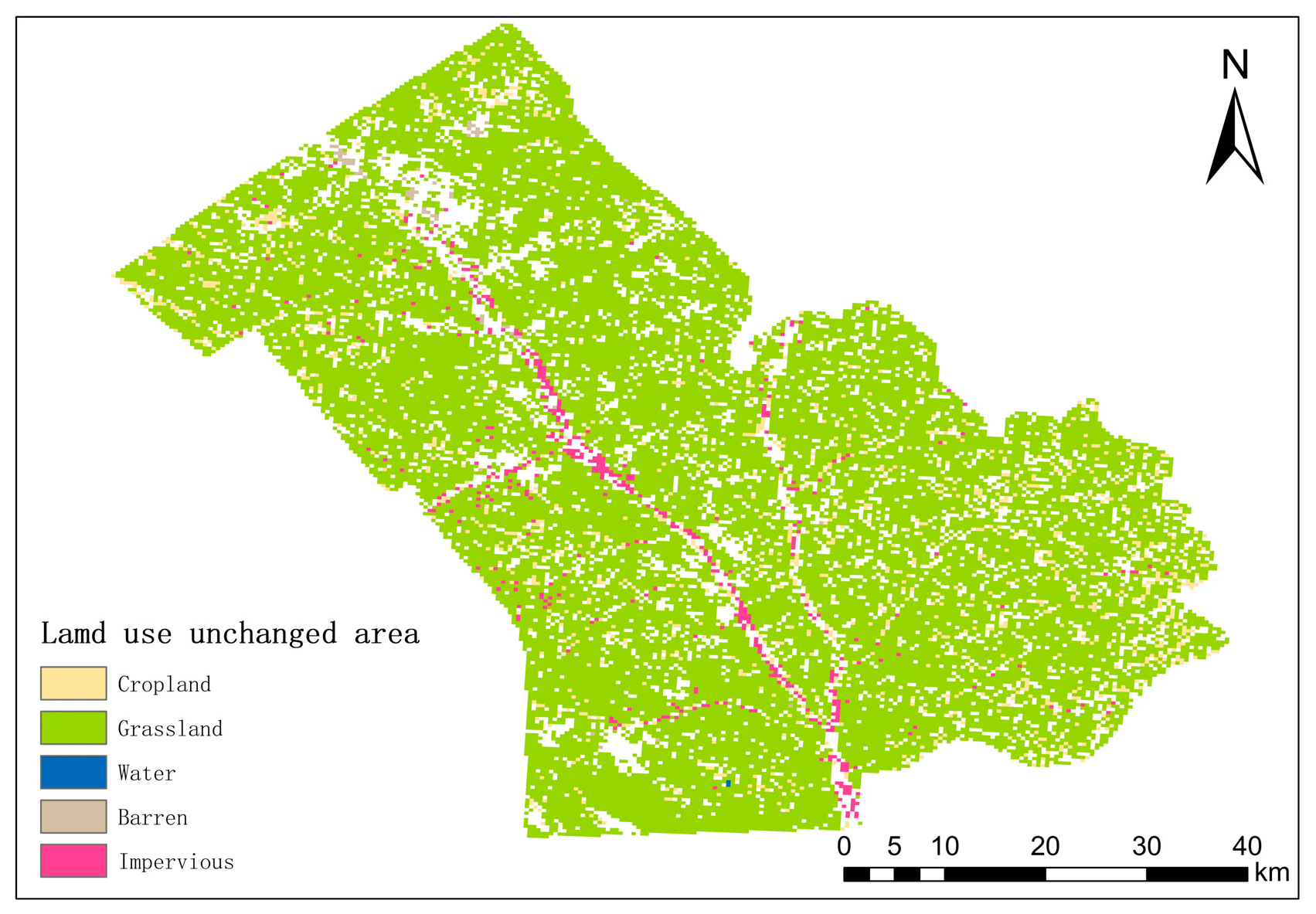
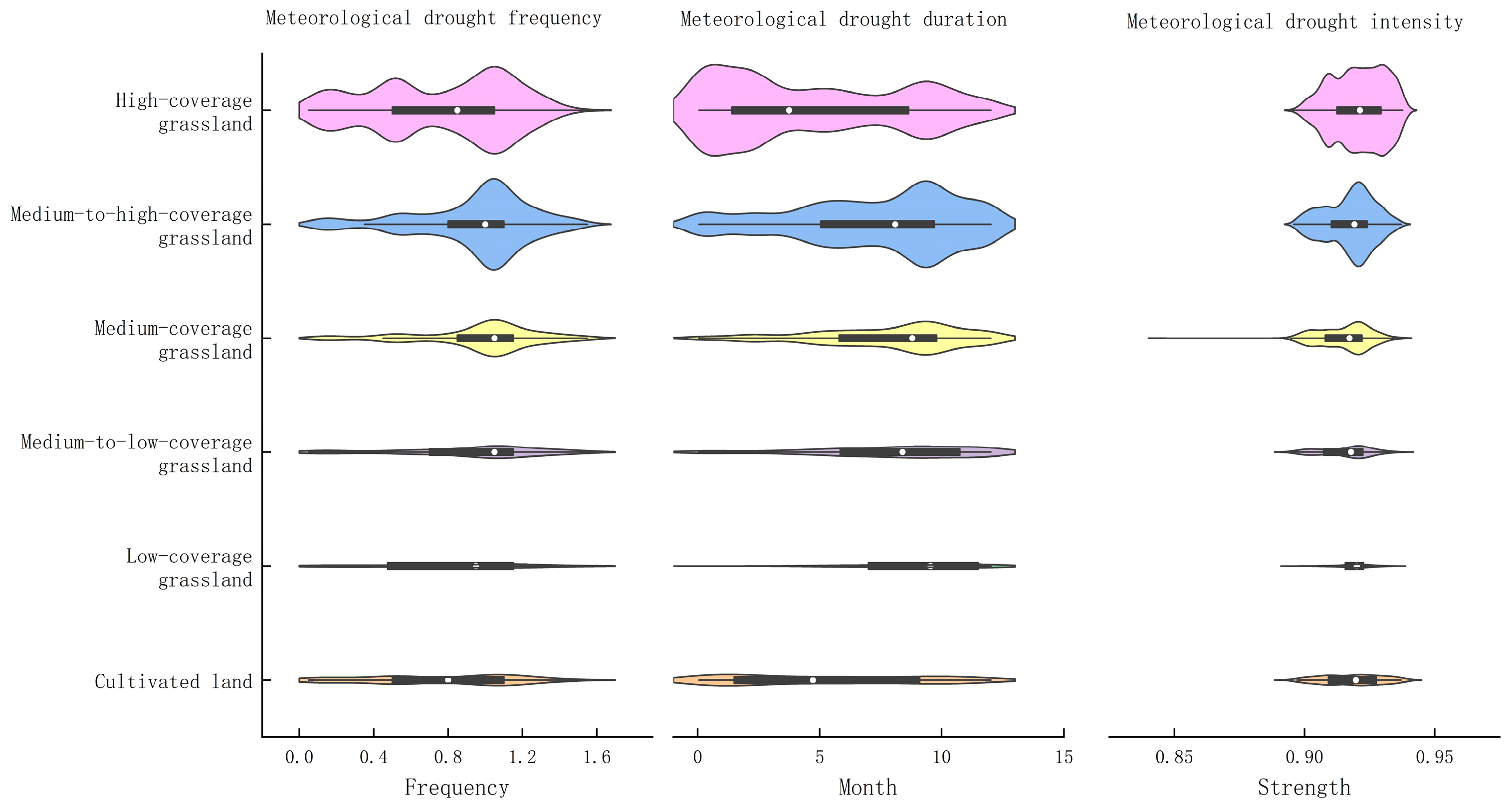
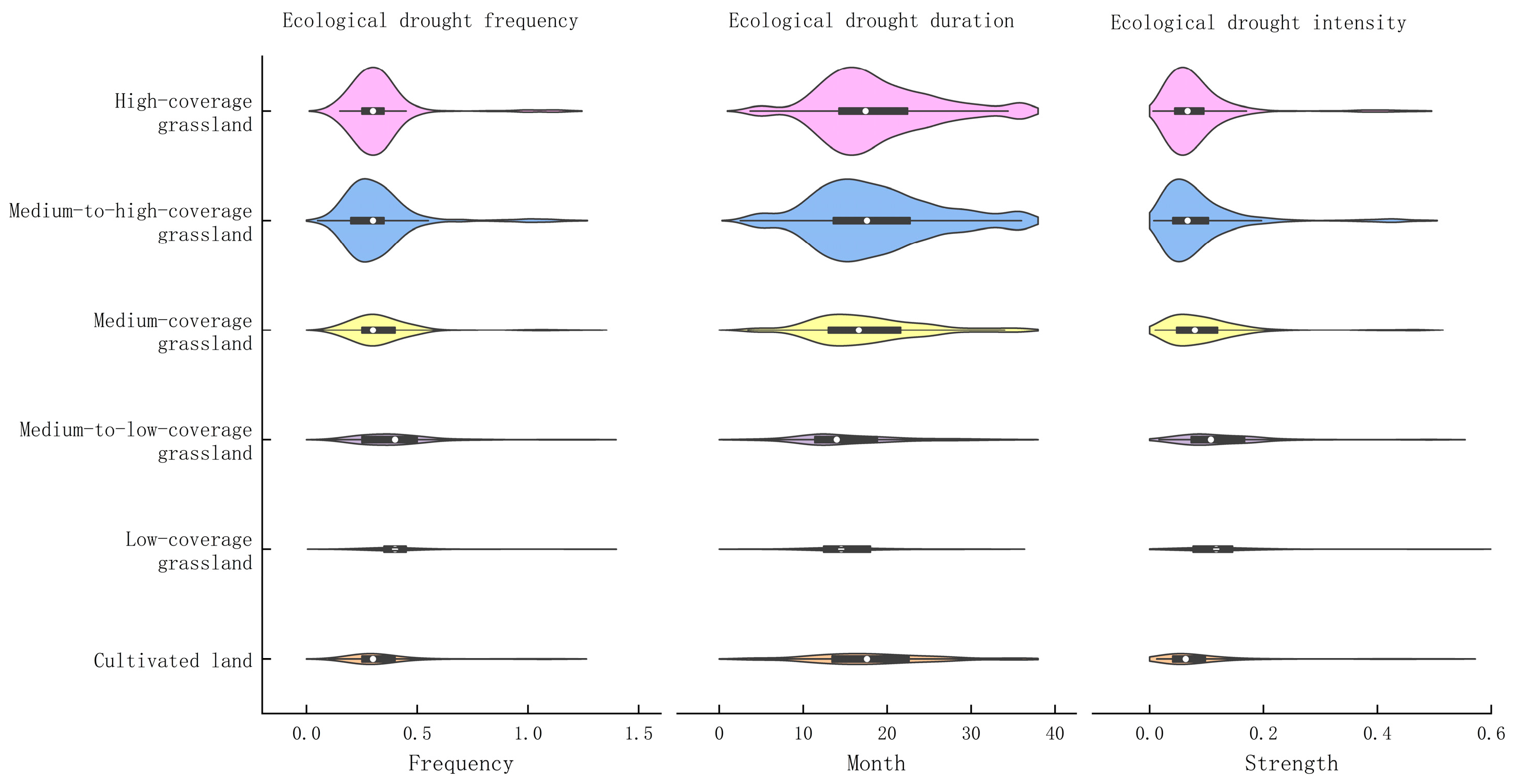

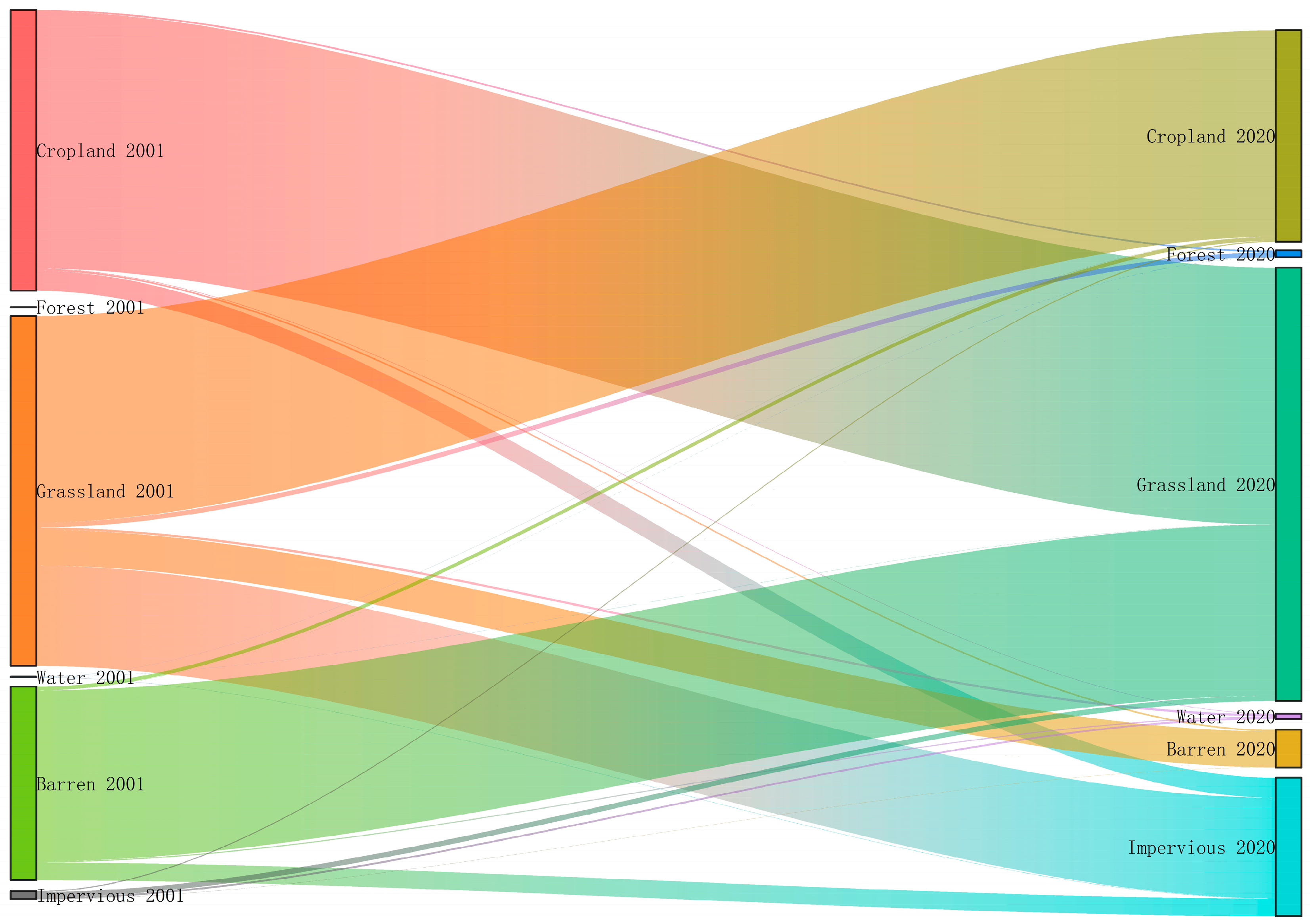
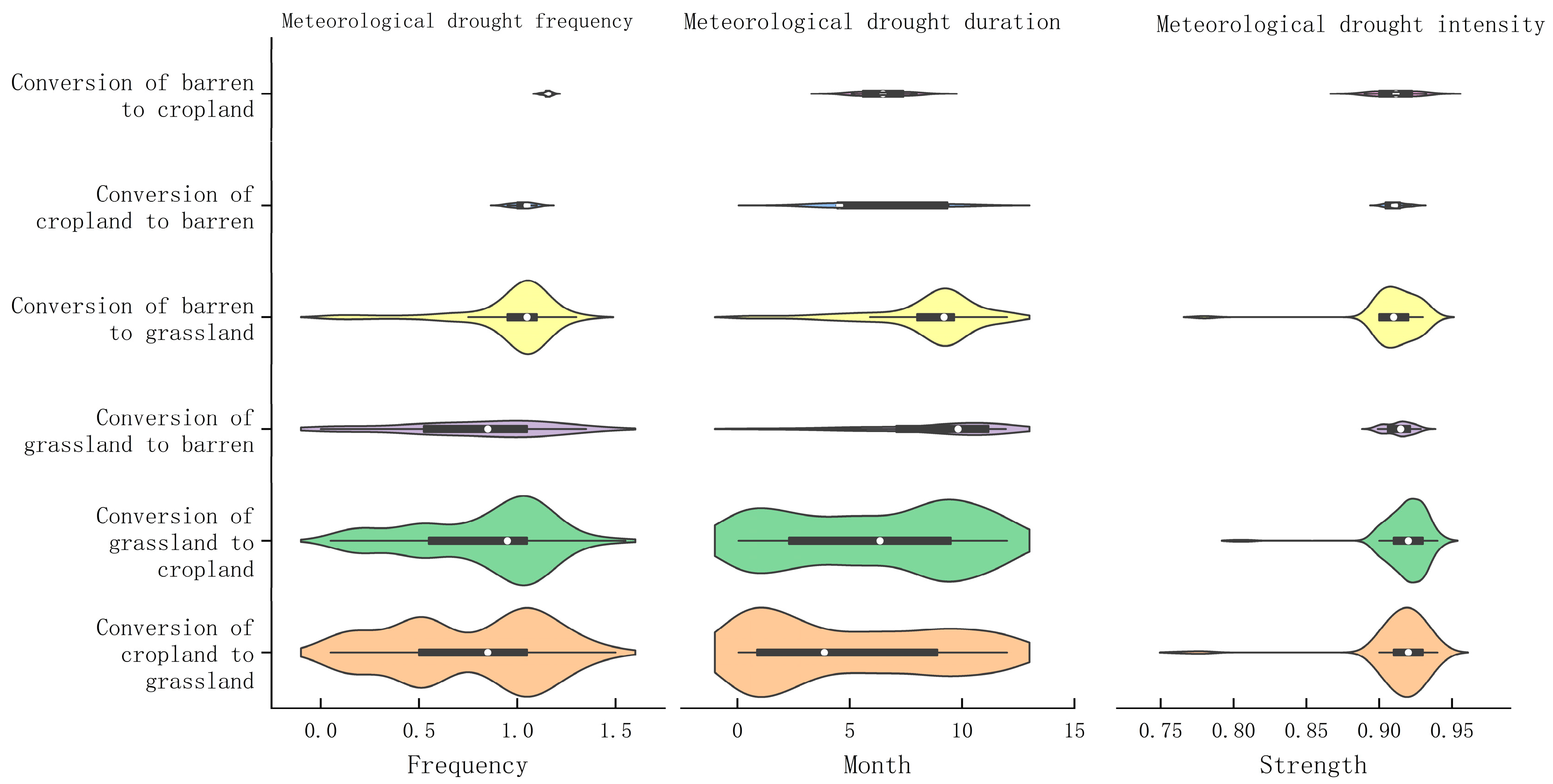
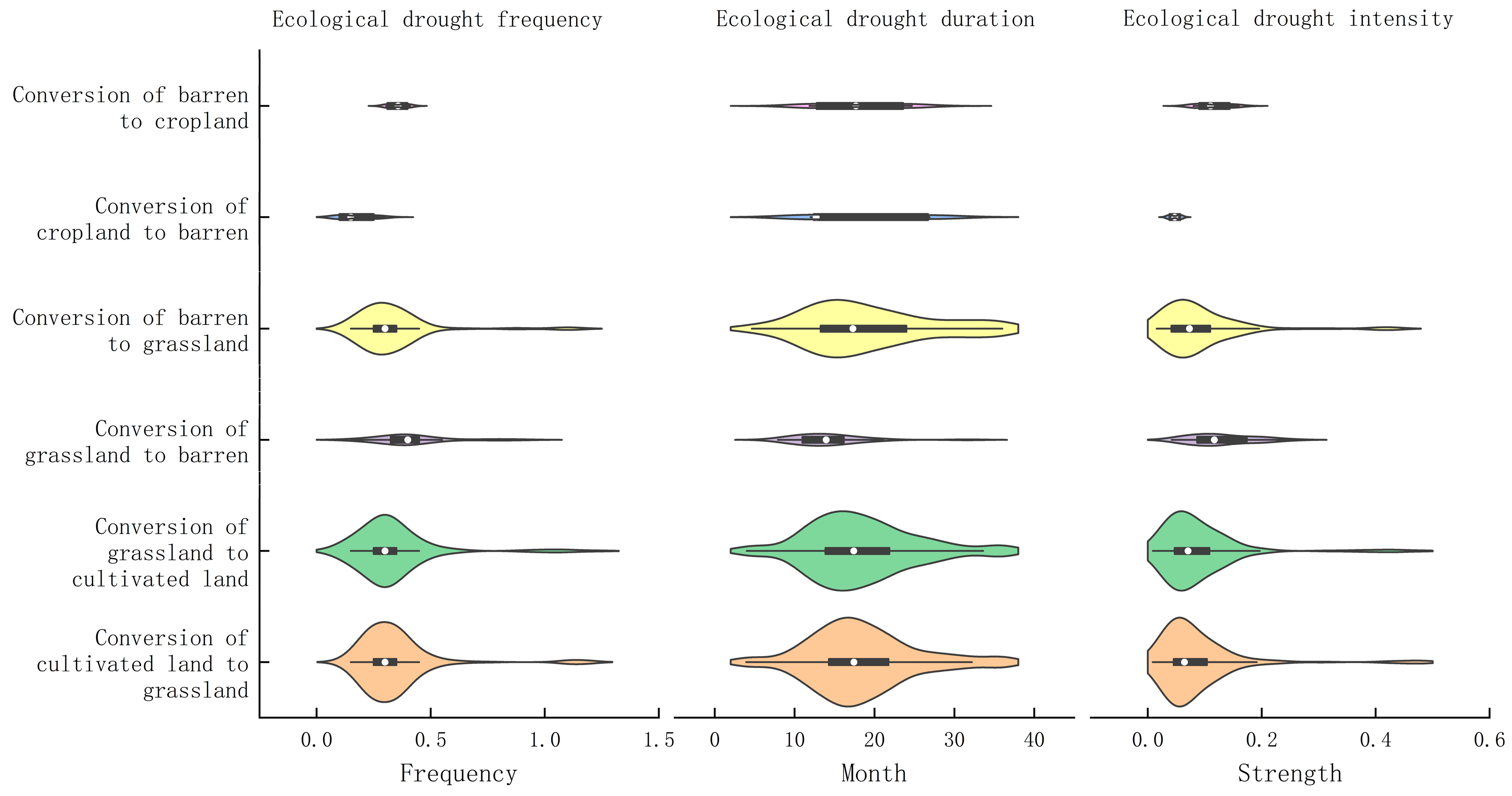


| Data Type | Data Name | Resolution | Time and Space Range | Time and Space Range of Use | Bibliography |
|---|---|---|---|---|---|
| GPP data | The China Regional PML-V2 Land Evapotranspiration and Total Primary Productivity Dataset | 1 day, 500 m | 2000.02.26–2020.12.31 | 2001–2020, 1 km | Zhang et al. [39,40,41,42] |
| Temperature data | 1 km monthly mean temperature dataset for China | 1 month, 1 km | 1901–2023 | 2001–2020, 1 km | Peng et al. [43,44,45,46,47] |
| Precipitation data | 1 km monthly precipitation dataset for China | 1 month, 1 km | 1901–2023 | 2001–2020, 1 km | Peng et al. [43,44,45,46,47] |
| Land use/land cover data | Annual China Land Cover Dataset, CLCD | 1 year, 30 m | 1985–2022 | 2001–2020, 1 km | Yang and Huang et al. [48] |
| Grade | Type | SPI Value |
|---|---|---|
| 1 | Normal drought and moist conditions | −0.5 < SPI |
| 2 | Mild drought | −1.0 < SPI ≤ −0.5 |
| 3 | Moderate drought | −1.5 < SPI ≤ −1.0 |
| 4 | Severe drought | −2.0 < SPI ≤ −1 |
| 5 | Extreme drought | SPI ≤ −2.0 |
| Correlation | Cropland | Grassland | ||||
|---|---|---|---|---|---|---|
| Low Vegetative Coverage | Low-to-Medium Coverage | Medium Coverage | Medium-to-High Coverage | High Vegetative Coverage | ||
| Drought frequency | 0.71 | 0.73 | 0.72 | 0.69 | 0.66 | 0.38 |
| Drought duration | 0.96 | 0.95 | 0.93 | 0.91 | 0.84 | 0.38 |
| Drought intensity | 0.37 | 0.75 | 0.41 | 0.41 | 0.40 | 0.11 |
| Correlation | Before Conversion | Cropland | Grassland | Grassland | Barren | Cropland | Barren |
|---|---|---|---|---|---|---|---|
| After Conversion | Grassland | Cropland | Barren | Grassland | Barren | Cropland | |
| Drought frequency | 0.68 | 0.68 | 0.59 | −0.15 | 0.56 | −0.26 | |
| Drought duration | 0.93 | 0.92 | 0.85 | −0.21 | 0.81 | −0.44 | |
| Drought intensity | 0.40 | 0.51 | 0.52 | −0.39 | 0.49 | −0.53 | |
Disclaimer/Publisher’s Note: The statements, opinions and data contained in all publications are solely those of the individual author(s) and contributor(s) and not of MDPI and/or the editor(s). MDPI and/or the editor(s) disclaim responsibility for any injury to people or property resulting from any ideas, methods, instructions or products referred to in the content. |
© 2025 by the authors. Licensee MDPI, Basel, Switzerland. This article is an open access article distributed under the terms and conditions of the Creative Commons Attribution (CC BY) license (https://creativecommons.org/licenses/by/4.0/).
Share and Cite
Qin, H.; Chen, Z.; Li, H.; Zhang, X.; Hao, C.; Wang, S.; Zhang, H.; Zou, Y. The Spatial Distribution and Transition of Meteorological and Ecological Droughts in the Shendong Mining Area. Remote Sens. 2025, 17, 1064. https://doi.org/10.3390/rs17061064
Qin H, Chen Z, Li H, Zhang X, Hao C, Wang S, Zhang H, Zou Y. The Spatial Distribution and Transition of Meteorological and Ecological Droughts in the Shendong Mining Area. Remote Sensing. 2025; 17(6):1064. https://doi.org/10.3390/rs17061064
Chicago/Turabian StyleQin, He, Zhichao Chen, Hao Li, Xufei Zhang, Chengyuan Hao, Shidong Wang, Hebing Zhang, and Youfeng Zou. 2025. "The Spatial Distribution and Transition of Meteorological and Ecological Droughts in the Shendong Mining Area" Remote Sensing 17, no. 6: 1064. https://doi.org/10.3390/rs17061064
APA StyleQin, H., Chen, Z., Li, H., Zhang, X., Hao, C., Wang, S., Zhang, H., & Zou, Y. (2025). The Spatial Distribution and Transition of Meteorological and Ecological Droughts in the Shendong Mining Area. Remote Sensing, 17(6), 1064. https://doi.org/10.3390/rs17061064





